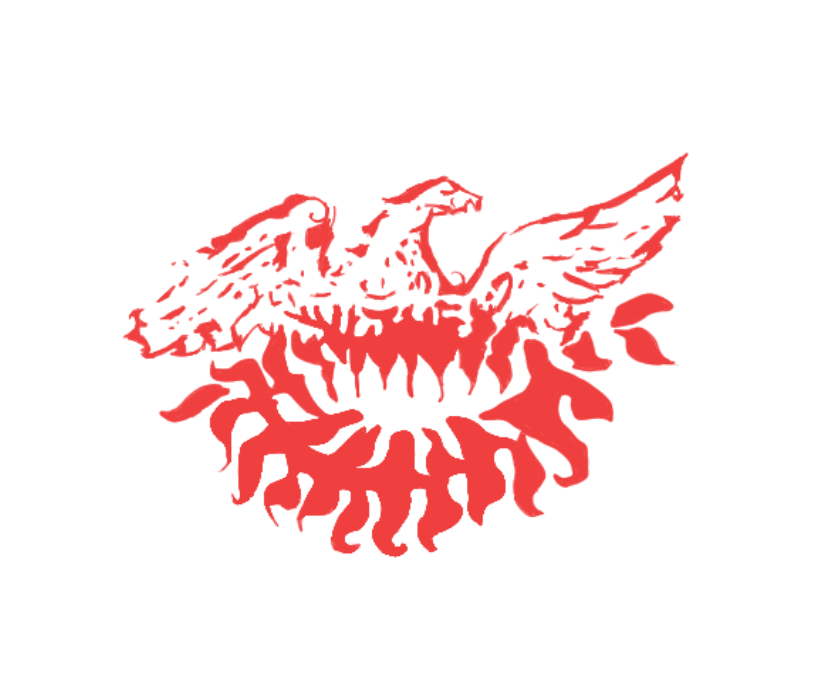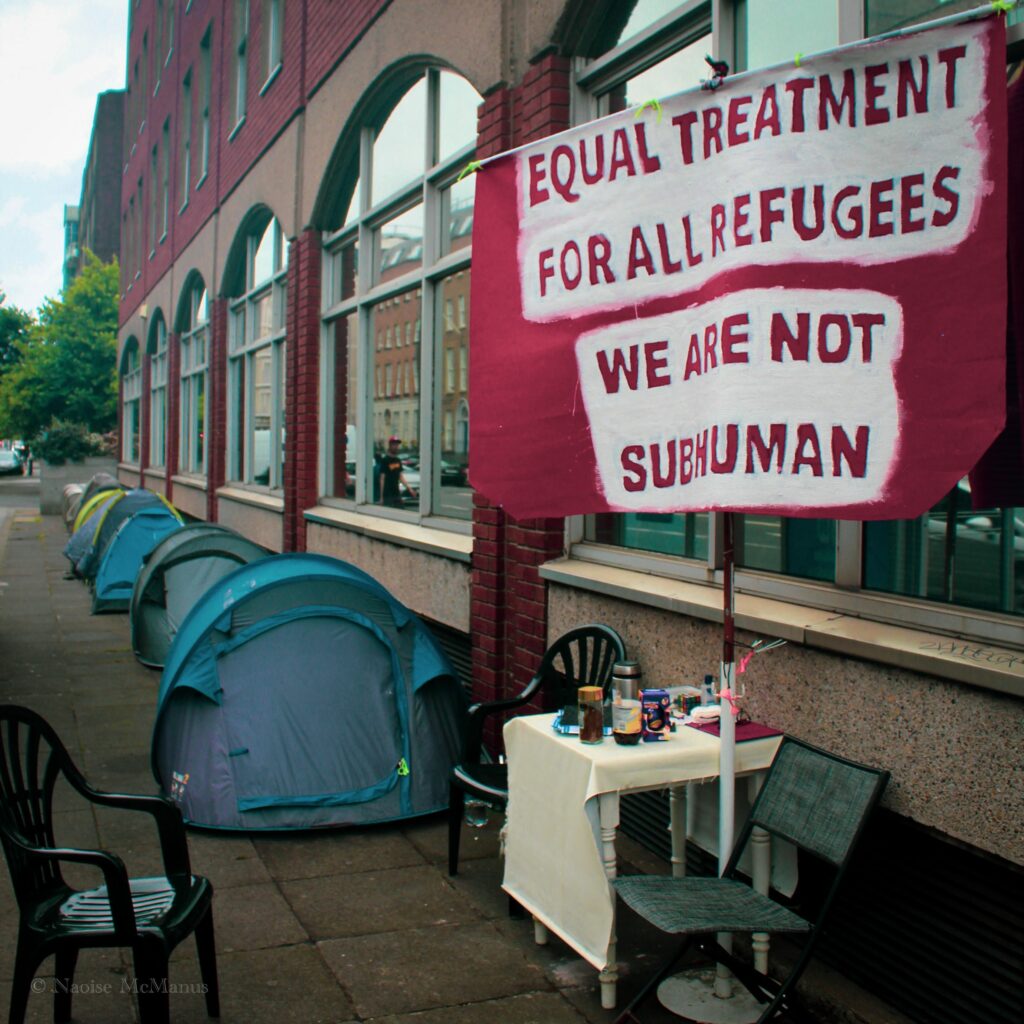By László Molnárfi
Wednesday 5 july 2023
László Molnárfi is the President of Trinity College Dublin Students’ Union – the views expressed herein are not the official view of TCDSU; and Chairperson of Students4Change, an alliance of socialist students.
Photograph from RTE: PhD researchers call for recognition as ‘workers’ By Emma O Kelly
According to Guy Debord, organiser of the Situationist International (SI) anti-capitalist movement, “in a world which really is topsy-turvy, the true is a moment of the false”. What appears as true is false; what is false is true. We, students, see this everywhere. Our third-level institutions profess to promote equality, diversity and inclusion in their words. Yet, in their actions, they increase fees and rents, put our teachers on insecure contracts and foster unethical connections with greedy politicians, big business and unsavoury industries. The account of reality under capitalism is truly flipped on its head, and the proliferation of the simulated reality knows no bounds. By-products of the capitalist university such as advertisements to draw in international students and then milk them for money, institutional surveys which end up nowhere, and the propping up of government politicians by inviting them for on-campus photo-ops flows from every tap.
Yet, there is a subtler form of spectacle imposed on us that exposes the value dissonance that exists under neoliberal capitalism. Student unions have become the friendly faces of the exploitation that the corporate university demands. Their decision-making organs have become the invisible occupation of the student body by the authorities.
It must not be chalked up to coincidence, for example, that the Union of Students Ireland (USI) and affiliated student unions have employed the rhetoric of decommodifying education yet will promote the StudentSurvey.ie tool, which is a consumer satisfaction survey. On a closer look, the National Student Engagement Program (NStEP), a collaboration of the government and the USI incorporating this survey, has provided €138,712 to the accounts of our national union in 2022. The advocacy goal of public education therefore stands in stark opposition with the promotion of this survey, in an instance of Orwellian doublethink. The walkout organised by the USI can be understood as an extension of this value dissonance – radical rhetoric, meagre action. It is a perfect indictment of student unions across the island because it shows the performative actions that underpin their strong words. The walkout itself had no escalation actions, lasted an hour and was even supported by senior management, in the case of the Provost endorsing it at Trinity College Dublin. In short, it was planned press management rather than movement building.
It must be established that the USI and the leadership in student unions is part of one assemblage. They both lack militancy. If the co-opted USI were to cease to exist, there would not be a resurgence of radicalism – there would simply be many co-opted student unions acting on their own and they would be more exposed to takeover by management as can be seen in the example of the University of Limerick’s Student Life. This is because the dominant ideology in student unions is one of surrender to the neoliberal reality.
When Dublin City University (DCU) decided to award a honorary degree to Bertie Ahern presumably with the aim of currying favour with the government, it was met with outrage, eventually leading to a disruption organised by students who called him “one of the architects of the financial crisis”. The student union did not offer a statement of support. This is despite having taken part in the student walkout, which not only identified the rising cost of living but placed the blame on the government. What is happening in student unions is that on the one hand, they are conveying a message of resistance, whereas on the other they are capitulating to the powers that be in cases where opposition would no longer be respectable as judged by the mainstream. Student unions cannot have the foot in both camps – they must unflinchingly take the side of the marginalised against those in power.
It is a trend. When it came to opposing a 10% fee increase for international students and postgraduates, the Trinity College Dublin Students’ Union (TCDSU) refused to take action, publishing only a statement after the fact and a photo-op with cow masks, they called no protest and did not even leak it to the press beforehand. The University of Galway Student Union (UGSU) recently signed a partnership agreement with its institution, to the outrage of students on Twitter, leading one of the commenters to proclaim “social partnership, the politics of surrender”. Ulster University Students Union (UUSU) does not support the University and College Union (UCU) teacher strikes for improved working conditions, and as such they have sided with senior management and the government.
When our communities are under attack from neoliberalism it is betrayal for our student unions to present themselves as the harbingers of change and then fail to carry out oppositional actions and unequivocally side with the struggle of students and workers. This is crucial, because student unions present themselves as the hegemonic image of the student movement, and consequently exclude alternative forms of organising. The ensemble of student unions are not independent actors, but are themselves extensions of the state apparatus and continuously assert their cultural hegemony over student activism by weight of their social power situated in capitalist power structures. Governments, institutions and the media recognize them as the rightful representatives of students; they recognize themselves as such. This is part of the spectacle as Guy Debord puts it, which “presents itself as something enormously positive, indisputable and inaccessible. It says nothing more than “that which appears is good, that which is good appears”. The attitude which it demands in principle is passive acceptance which in fact it already obtained by its manner of appearing without reply, by its monopoly of appearance”.
The co-optation of student unions finds its roots in neoliberal ideology that first began to appear in the 1970s. Through exploiting economic incentives, the ideology of making society subservient to the interests of capital has the ability to co-opt organisations. As third-level institutions are underfunded and start to market themselves like products, students start to identify as consumers and student unions view themselves as consumer representative bodies rather than radical and mass organisations which seek to change the world.
As this happens, student union leaders soon learn the corporate language and the way of making change in meeting rooms. Quality assurance to get “value for money” as an important criteria, being built into grievance procedures and being able to assist students in official structures are ways to dampen radical inclinations and work with the system. Mimicking the labour market, unions also take up mile-wide and inch-deep methods of engagement, and count student engagement in superficial interactions rather than in mobilising capacity. So, for example, how many people attended parties, received goodie bags or used a service. Equally the onset of student unions acting as a loudspeaker for its institution and serving to prop up the “student experience” comes from the introduction of league tables – an essentially commodifying system – in which neither party benefits from publicly bashing the other as student numbers ensure income to both organisations. Finally, as third-level institutions face austerity and cut vital services to save money, student unions take up the slack.
Thus, there develops an alienating model in which students are kept at an arm’s length. The aim is now service provision, and the delivering of inner-institutional change professionally for the students, but not anything beyond that with the students through a mass movement. Student unions still have democratic elements, and are thus propelled to at least show the appearance of taking action, but set narrow constraints for themselves in what is permissible. Due to this there arises an opposition within the union’s proposed objectives and the way they carry them out – value dissonance.
We like to think that the groups we are part of are immune to capitalist logic but we must face the sober fact that a powerful territorialization has occurred whereby our representative bodies have dissolved their change-making potential into the hegemonic image of the mode of production, transforming student unions into apolitical, toothless service providers. We must reverse this process, and alongside organising in grassroots groups like Students4Change, we must run radical slates and attempt to take back our student unions and engage them in militant struggles. Student unions must become radical, or they will become redundant.



